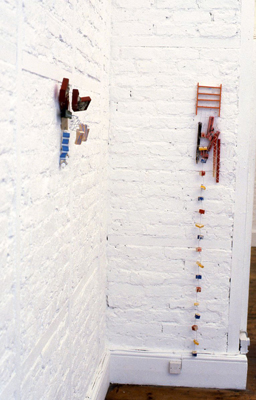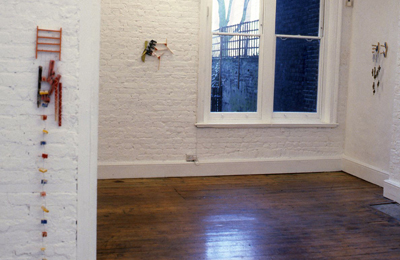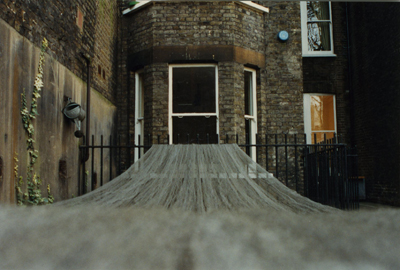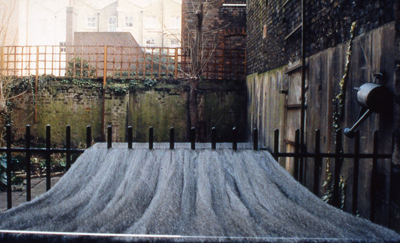Fennick-Streather
- Bobbie Fennick – Elements
- Bobbie Fennick, Elements – Jean-Paul Martinon
- Simon Streather – Objects
- Simon Streather, Objects – Jean-Paul Martinon
Simon Streather, Objects - Jean-Paul Martinon
Rear Window Publications
1993 © Jean-Paul Martinon
Along with many other people, you’ve been invited to an art gallery to see a show of “objects” by Simon Streather. If you know his work, you know what to expect. If you don’t, here is the journey you could go through while looking at them.
First of all, you discover the scraps of wood, the bits of paper, the segments of steel, the bits of shreds and the game of colours. Everything is tangled together to form a multicoloured object—a multicoloured thing mysteriously nailed to the wall, a row of multicoloured hanging objects. You then notice the little bits of glue here and there, the sewing, and all the piercing. You could conclude that you are standing in front of elaborate structures, un-definable and so far meaningless.
What strikes you is that the materials are bound together in a non-hierarchical relationship. None of the elements dominate the others. However, you feel that their geometry is random and oddly unjustifiable. This has a power of fascination: how does it hold together? At this stage, you realise that you can’t yet get an answer to such a question.
Therefore, you start from the beginning; you glance at the materials.
For the most part, the materials are plain, i.e. uncovered with glaze or varnish. They are bare; some of them are quickly painted. They have an unfinished look, which makes the objects appear even frailer. When you are sure no one is looking at you, you touch one with your finger: they feel fragile and insubstantial.
After this first step, you analyse your first impressions. You realise that they are simple collages of heterogeneous components. Not a display of eclectic objects but intricate games of connections. The materials seem to depend on each other. They seem happy to live in close association. That’s it, you’ve got it: A symbiotic existence, which holds them together. The rules of which appear secret and mysterious. This inner-connection makes them unique and distant—unapproachable even. This aspect of the work makes you feel uneasy. Your pre-conceived interpretative faculties are useless and unproductive. You feel foolish and slightly irritated.
To avoid such feeling, and because you are persuaded that you are interested in art, you decide to imagine their life: on display on a nail for a time and then packed in a tiny shoebox for another. You imagine them getting scratched and forever entangled with one another. You realise then, that their structure is valid only if shown otherwise they don’t exist. The display and the space around each object suddenly become relevant: the walls highlight their plainness and their elaborate structure. It’s all part of it. You feel slightly better. At least, you got something out of them. You feel more confident and you go to answer the next question that comes to your mind:
Are they sketches? Sketches for future sculptures? Mini-sculptures? A sophisticated display of sketches for future sculptures?
Silence... Sketches... They breathe of incompleteness. You can’t get around with them. They are not “there” yet...
Nevertheless—yet again—you feel that their half measure appearance is rather daunting. Not as metaphors (for what?), but as subjective objects, as objects about the subjective, as objects that are sketches of objects-to-be...You’ve got it! They are object-sketches of objects-to-be! You start to breathe normally again.
But you are still irritated, you find them contrived and inaccessible; they are giving you a lot of work. Because of their “irritating-daunting” aspect, you make another effort; you start following them, you reconstruct the inner play that has led the artist to the “final” object. You take apart and then you reassemble the bits and pieces and you re-do the embroidering work. What appears to you is an infinite range of possible directions, an infinite range of possible shapes and structures. From this endless series of choices, you come back, still curious, to the hanging object; and sure enough, they appear like little intricate investigations: the result of an endless game of patience where the aim gives the impression of being the actual exhaustion of choice.
You now feel closer to the work. You feel you know it. They are object-sketches of objects-to-be. You’ve reconstructed the embroidering work and came out of it acknowledging your own state of continuous desire and curiosity, a state that has led you to the “object” finally “reconstructed.”
Less and less irritated and rather proud of yourself, you escape back again into the game of discovery the object provides. You re-enter the subjective world they were created in, a subjective wandering world that looks familiar and yet unusual and with a bizarre taste of childhood. You wander, you get lost, but you feel more confident on all those slopes and twists the object offers you. You enjoy for a minute a little corner there and the funny shape of the steel-wire on the left. You smile looking at a rather suggestive figure... you let yourself go.
In the middle of your escapism, you feel again the need to re-structure the whole object and to see it again. You worked so hard in trying to understand it that you nearly re-created it. You add the walls to your game of objectification and little by little, the whole show. And yet again, you feel justified. This time the continuum itself—your wandering—created the reason of your being there, looking at the work. The connections of scraps and sections of wood, metal and paper, the annoying little string and its nail full of contempt, the relation between the object and the brick walls, everything becomes all knowledge to you. An unnecessary knowledge that now has a touch of familiarity. You have de-created and re-created the object and you exult.
You look at them again, lifting the eyebrow. This time, its you, who is distant. You wait a little bit more and with a more or less objective eye, you realise that you are disappointed. That the knowledge you now have actually represents the lingering and the wandering itself and that is all. The objects are just the result of a game of wandering/wondering. You feel caught and irritated again.
As a last resort, you decide to get some help from historical references. You recall the anti-aesthetics of the late 60s and early 70s. You realise that it is at least avoiding the blending of styles and the blankness of the 80s and you feel better. A feeling of superiority invades you again. Those objects are free of hypothetical codes and systems. They are beyond language; they interpret the means of interpretation and stay in the narrow line of intra-linguistic art. You are about to go, convinced by your last discovery, persuaded that the objects have nothing else to offer. But somehow you decide to linger some more in front of them. You feel itchy and quixotic: are they really linked to a theoretical support? Deconstruction? Dematerialisation? Anti-Art?... It is getting on your nerves.
Perplexed, you conclude that they are an attempt to get out of the nihilistic prison house of art discourse. After all, they don’t refer to art materials as such. They are just annoying presences for themselves. You pause for a moment. Yes, you feel that you’ve been contradictory. You throw away historical references as no longer relevant.
Finally, you try psychology. That should kill the worm. What do they express? What do they hide, those toy-like objects? Some ghastly complex?
Suddenly you start to see lots of possible hidden symbols for breasts and penises. You shift away those simplistic views and you persuade yourself that they situate themselves between the wonder of the child—the toy factor—and the assurance of the adult—the “object d’art” factor. You allow yourself another banal interpretation—like, for instance, that they are an attempt to evade masculinity and femininity—until you realise that the embroidering could simply be interpreted as a game of patience.
So? All your interpretative faculties have failed you and like everyone else, you conclude by thinking in terms of poetry. A good melting pot for all kinds of interpretations; a good way out. And sure enough, you find them “poetic.” Because you know a bit about visual arts and because you don’t know what a Haiku is; you finish by thinking in terms of Haiku. Their harmonious structures and ethereal aspect convince you of the parallel. This is unquestionable. No counter-argument comes up in your now very tired brain. You feel exhausted and disoriented. You just want to let yourself go, fascinated by that little bit of wood and the rectangle just there. You feel you should follow the lines and start again your descent inward, outward, letting yourself go on a journey full of curiosities.







